A Manual Task object represents an activity a person performs offline and/or in the physical environment such that ProcessMaker Platform cannot monitor its activity. A Manual Task object is different than a Form Task object, in which a person performs an activity via a Screen. ProcessMaker Platform relies on the Task assignee to acknowledge completion of that activity. An example of a Manual Task activity is moving physical merchandise in a warehouse: this activity occurs offline and is one which does not involve ProcessMaker Platform interaction.
Add a Manual Task to the Process Model
Permissions
Your user account or group membership must have the following permissions to configure a Manual Task Object in the Process model unless your user account has the Make this user a Super Admin setting selected:
Processes: Edit Processes
Processes: View Processes
See the Process permissions or ask your Administrator for assistance.
Add a Manual Task object from one of the following locations in Process Modeler:
Object Panel: Located to the left of the Process Modeler, the Object Panel contains various process modeling objects.
Object Bar: Located at the bottom of the Process Modeler, the Object Bar contains pinned Process modeling objects for quick access.
Follow these steps to add a Manual Task from the Object panel to the Process model:
Ensure that the Object panel is visible. If not, click the Add icon
 from the Object bar at the bottom.
from the Object bar at the bottom.Click the Task object
 from the Object panel to select it.
from the Object panel to select it.Click the location in the Process model to place this object. Follow these guidelines when placing this object:
If your process has a Pool object, the object cannot be placed outside of the Pool.
To place this object between two existing objects, follow these instructions.
Click the objects drop-down menu, and then select the Manual Task option.
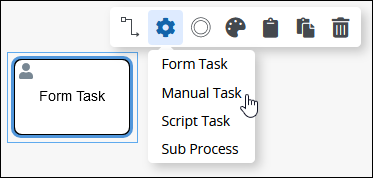
The Manual Task object displays.

Follow these steps to add a Manual Task from the Object bar to the Process model:
Ensure that the object is pinned to the Object bar. If not, see instructions to pin it.
In the Object bar at the bottom center, click the object's icon.
Click the location in the Process model to place this object. Follow these guidelines when placing this object:
If your process has a Pool object, the object cannot be placed outside of the Pool.
To place this object between two existing objects, follow these instructions.
Click the Objects drop-down menu, and then select the Manual Task option.
 The Manual Task object displays.
The Manual Task object displays.
Add boundary events
- Boundary Timer Event element
- Boundary Error Event element
- Boundary Signal Event element
- Boundary Conditional Event element
- Boundary Message Event element
Replace a Manual Task Object with a Different Task Type or Sub Process Object
After a Manual Task object is added to a Process model, you may replace it with a different Task type or a Sub Process object:
Form Task object
Script Task object
Sub Process object
The selected Manual Task object is replaced by the default settings and color of the replacing object.
Follow these steps to replace a Manual Task object with a different Task type object or a Sub Process object:
Select the Manual Type object to change to another object. Available options display above the selected object.
Click the Objects icon. The Objects drop-down menu displays the Task type objects and the Sub Process object.
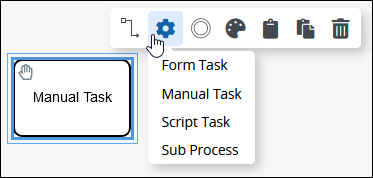
Select the object to replace the Manual Task object. The Change Type screen displays to confirm replacing the currently selected object.
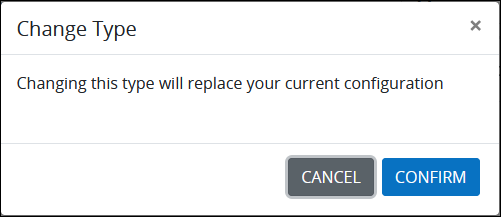
Click Confirm. The new object replaces the Manual Task object with its default settings and color.
Preview the Screen for the Task
After a Manual Task object is added to a Process model and selected the Screen for the Task, you may preview the associated Display Screen, which allows you to interact with and verify the Screen content in the same Process Modeler.
Follow these steps to preview the associated Display Screen from a Manual Task object:
Select the Manual Task object to preview the associated Screen. Available options display above the selected object.
Click the Preview icon
 . A preview window displays on the right-side of the Process Modeler.
. A preview window displays on the right-side of the Process Modeler. 
Previewing the Screen for a Manual Task object
In the Preview window, you can do the following:
Click the icon
 to open the Screen Builder to edit the Screen.
to open the Screen Builder to edit the Screen.Click the icon
 to close the preview window.
to close the preview window.Click another Task or connector object to change the asset in the same preview window.
The following message displays if you try to preview a task with no associated screens.
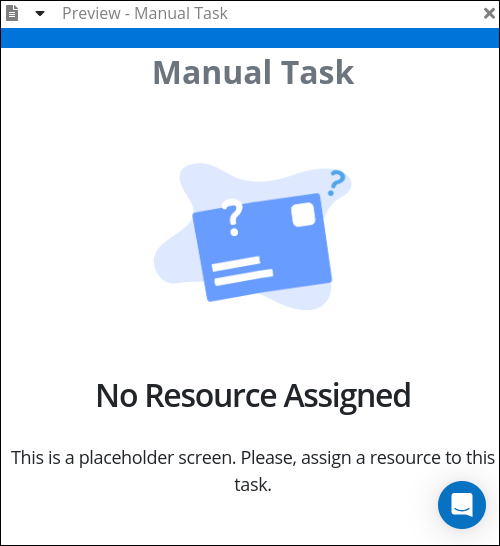
Settings
The Manual Task object has the following panels that contain settings:
Configuration panel
Loop Activity panel
Documentation panel
Assignment Rules panel
Notifications panel
Vocabularies panel
Advanced panel
Configuration Panel Settings
The Manual Task object has multiple settings in the Properties panel:
Edit the object Name
An object name is a human-readable reference for a Process object. Process Modeler automatically assigns the name of a Process object with its object type. However, an object's name can be changed.
Follow these steps to edit the name for a Manual Task object:
Select the Manual Task object from the Process model in which to edit its name.
Expand the ConfiguratioEnsure that the Configuration panel displays. If not, show it. The Name setting displays. This is a required setting.
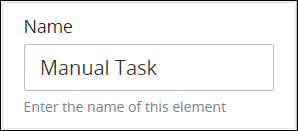
In the Name setting, edit the selected object's name and then press Enter.
Select the Task Destination
Specify the destination to which users are redirected after completing a task. By default, users return to their original access point, such as a task list, dashboard, or previous page. You can override this behavior to redirect users to locations such as the process LaunchPad, a specific dashboard, or an external URL.
Follow these steps to select a object destination:
Select the Form Task object from the Process model.
Click the
 icon to view the Configuration panel.
icon to view the Configuration panel.From the Task Destination drop-down menu, select the page to display after a user completes this task.
.png)
Select one of the the following options. Selecting a destination object other than Task Source will render the Display Next Assigned Task to the Task Assignee feature unusable since the object will have an alternate destination.
Task Source (Default): This option redirects the user to the original access point where the task started.
Task List: This option redirects the user to the Task list.
Process Launchpad: This option redirects the user to the Process Launchpad.
Welcome Screen: This option redirects the user to the Participant Welcome Screen.
Custom Dashboard: This option redirects the user to a dashboard. After selecting Custom Dashboard, a dropdown menu appears below to select the desired dashboard.
.png)
External URL: This option redirects the user to an external URL. After selecting External URL, a dropdown menu appears below to enter the URL.
.png)
Display Next Assigned Task
Use the Display the Next Assigned Task option to automatically take the user to the next task if it is assigned to them. If the next task is assigned to a different user, then the To Do Tasks page displays after Task completion.
Select the Display the Next Assigned Task option.
From the Screen Interstitial setting, select the Screen to display after this Task completes and before the next Task begins.
.png)
Benefits of Using Interstitial ScreensSmooth Task Transitions: Display a loading screen (e.g., "Loading your next Task") while a request routes to the next form-based Task.
Prevent Abrupt Endings: If a script task is followed by an end event, show a summary screen instead of abruptly ending the request.
Note:
Task Destination setting applies whether the user is completing the task while logged into ProcessMaker or as an anonymous user through a web entry.
If an Interstitial Screen follows a Web Entry Start Event in a child request, it cannot redirect back to the parent request—only to tasks within the child request.
Select the Screen for the Manual Task
When a Manual Task object triggers, a Screen can display instructions or information in its Task summary so its Task assignee can perform the manual Task. The Screen must be of Display type.
When a Manual Task object is placed into a Process model, it is not configured to display a Screen when it triggers. Therefore, it must be configured.
Follow these steps to select the Screen that displays when a Manual Task object triggers:
Select the Manual Task object from the Process model in which to select the Screen that displays when that Manual Task object is triggered, thereby providing instructions or information to the Task assignee.
Ensure that the Configuration panel displays. If not, show it. Panels to configure this object display.
Expand the Configuration panel if it is not presently expanded, and then locate the Screen for Input setting.
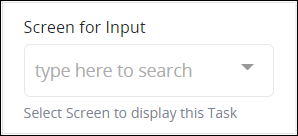
Do one of the following:
From the Screen For Input drop-down menu, select which Screen that Manual Task object references. After a Screen is selected, the Open Screen link displays.
Click the Create a new screen link. A new browser window opens to create a new Screen. After creating the Screen, the Screen for Input drop-down menu automatically populates with the created Screen. Otherwise, be sure to select the new Screen in the Screen For Input drop-down menu.
Optionally, click the Open Screen link to view and/or edit your selected Screen. Note that your user account must have appropriate Screen category permissions to view and/or edit the selected Screen.
Add a Placeholder for the Slideshow Mode
The Slideshow Mode makes it easy for process designers to share the design of a process with all stakeholders, regardless of whether they have access to the ProcessMaker Platform. For more information on how to create slideshows for a process, see Slideshow Mode.
Follow these steps to add a placeholder image for the Slideshow Mode:
Select the Form Task object from the Process model.
Click the
.png) icon to view the Configuration panel.
icon to view the Configuration panel.From the Placeholder for Slideshow section, click on the +Drag or click here button to upload an image.
.png)
A preview of the image will display, and the configuration will be auto-saved.
.png)
The uploaded image will be shown for this task the next time the slideshow is viewed.
Size of a placeholder image for slideshows must less than 2 MB.
Image files with PNG, JPG, JPEG, and GIF extensions are supported.
Loop Characteristics Panel Settings
Use the Loop Activity panel settings to specify how to perform multiple instances of this object. The following loop modes are available:
No Loop Mode
Select the No Loop Mode option to perform this object's Task only once.
Follow these steps to specify characteristics to perform multiple instances of the Task:
Select the Task from the Process model. Panels to configure this object display.
Expand the Loop Activity panel. By default, the Loop Mode setting is set to No Loop Mode and the function is performed only once.
.png)
Loop
Select the Loop option to sequentially repeat this Task's function multiple times until an exit condition is True. This is useful when a function should be performed multiple times with the same set of data, such as, processing a credit card payment. This loop mode has the following characteristics:
The Task's function is repeated until the exit condition is
Trueor the maximum iterations limit is reached.At any given time, only one instance of the Task is active. The subsequent instance does not begin until the current instance completes.
The same exit condition evaluates at the end of each instance; however, value(s) of the Request variable(s) used in the exit condition can change during an instance resulting in the exit condition to eventually evaluate as
True.If any one instance of that function does not complete, workflow pauses.
All active instances are terminated if an interrupting boundary-type event object triggers.
 An object configured in this mode shows the Loop icon in Process Modeler.
An object configured in this mode shows the Loop icon in Process Modeler.
Follow these steps to specify characteristics to perform multiple instances of the Task:
Select the Task from the Process model in which to specify multiple instance characteristics. Panels to configure this object display.
Expand the Loop Activity panel to display the Loop Mode Setting.
From the Loop Mode setting, select the Loop option. The settings for this loop mode display:
.png)
In the Maximum Iterations setting, enter an integer value representing the maximum number of times this Task should be performed.
In the Exit Condition setting, enter a condition in FEEL syntax. When this condition is True the loop activity is halted.
Multi-instance (Sequential)
Select the Multi-instance (Parallel) option to perform this Task's Task multiple times in parallel a fixed number of times. This is useful when performing any action in bulk, such as sending an email to several people. This loop mode has the following characteristics:
Instances of the Task are governed by the size of an array-type Request variable where a new instance is created for each item in this variable. For example, an array with 10 items will create 10 parallel instances of this function that each contains data from its respective array index.
All instances begin simultaneously when this Task triggers; however, they perform their function independently of each other.
The function as a whole completes when all instances are complete.
The output from each instance can either be saved in the source Request variable or a new array-type Request variable.
All active instances terminate if an interrupting boundary-type event object triggers.
A Task configured in this mode shows the Multi-instance (Parallel) icon
 in Process Modeler.
in Process Modeler.
Follow these steps to specify characteristics to perform multiple instances of the Task:
Select the Task from the Process model in which to specify multiple instance characteristics. Panels to configure this object display.
Expand the Loop Activity panel to display the Loop Mode Setting.
From the Loop Mode setting, select the Multi-instance (Parallel) option. The settings for this loop mode display:
.png)
In the Request Variable Array setting, enter the name of an array-type Request variable. The size of this array will determine how many times this loop iterates.
In the Output Data Variable setting, enter the name of an array-type Request variable in which to store the results of all instances. Each instance of the loop saves to a separate JSON object within the array of the specified Request variable. If the Output Data Variable setting is not configured, then the output data replaces the source data in the Request Variable Array.
Multi-instance(Sequential)
Select the Multi-instance (Sequential) option to perform this Task's function multiple times sequentially a fixed number of times or until an exit condition is True. This is useful when sequentially repeating a function multiple times but with a different set of data each time. This loop mode has the following characteristics:
Instances of the function are governed by the size an array-type Request variable where a new instance is created for each item in this variable. For example, an array with 10 items will create 10 parallel instances of this function that each contains data from its respect array index.
At any given time, only one instance of the function is active. The subsequent instance does not begin until the current instance completes.
At the end of each instance an exit condition evaluates and the loop activity halts if the exit condition is
True.The function as a whole completes when all instances are complete.
The output from each instance can either be saved in the source Request variable or a new array-type Request variable.
All active instances terminate if an interrupting boundary-type event object triggers.
A Task configured in this mode shows the Multi-instance (Sequential) icon
.png) in Process Modeler.
in Process Modeler.
Follow these steps to specify characteristics to perform multiple instances of the Task:
Select the Task from the Process model in which to specify multiple instance characteristics. Panels to configure this object display.
Expand the Loop Activity panel to display the Loop Mode Setting.
From the Loop Mode setting, select the Multi-instance (Sequential) option. The settings for this loop mode display:
.png)
In the Request Variable Array setting, enter the name of an array-type Request variable. The size of this array will determine how many times this loop iterates.
In the Exit Condition setting, enter a condition in FEEL syntax. When this condition is True the loop activity is halted.
In the Output Data Variable setting, enter the name of an array-type Request variable in which to store the results of all instances. Each instance of the loop saves to a separate JSON object within the array of the specified Request variable. If the Output Data Variable setting is not configured, then the output data replaces the source data in the Request Variable Array.
Documentation Panel Settings
Describe the object's purpose and how it functions in the Process. This description does not affect Requests for the Process, but may be useful for Process model maintenance such as how the object is configured. Edit information by using the What-You-See-Is-What-You-Get (WYSIWYG) rich text editor.
A Process's entered documentation displays by selecting the View Documentation icon for that Process.
Edit the Object Documentation
Follow these steps to edit the description for an object:
Select the object from the Process model in which to edit its description.
Ensure that the Configuration panel displays. If not, show it. Panels to configure this object display.
Expand the Documentation panel if it is not presently expanded. The Description setting displays.
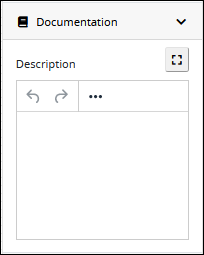
In the Description setting, edit the information to display when viewing documentation for this object and then press Enter. Alternatively, use the What-You-See-Is-What-You-Get (WYSIWYG) rich text editor to stylize your text by clicking the More icon
 .
. 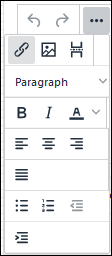
Follow these guidelines to use the WYSIWYG rich text editor to stylize your text:
Undo changes: Click on the
 icon to undo the last action.
icon to undo the last action.Redo changes: Click on the
 icon to redo the last undone action.
icon to redo the last undone action.Insert/Edit Link: Click on the
 icon to convert the selected text into a hyperlink. Follow these steps to create a hyperlink:
icon to convert the selected text into a hyperlink. Follow these steps to create a hyperlink: Select the required text from the Rich Text control.
Click on the
 icon. The Insert/Edit Link screen displays.
icon. The Insert/Edit Link screen displays. 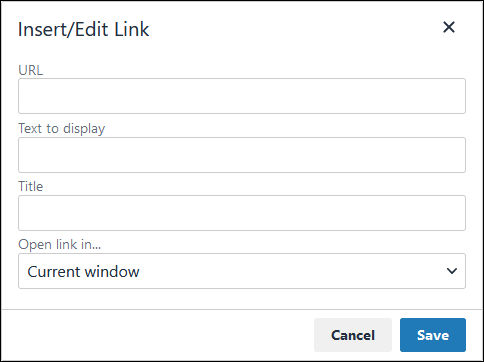
In the URL setting, enter the destination URL.
In the Text to display setting, edit or enter the text displayed in the Rich Text control.
In the Title setting, enter the text to display when a user hovers over the displayed text.
From Open link in… drop-down menu, select one of these options:
New window: Select this option to open the destination page in a new browser window.
Current window: Select this option to open the destination page in the current browser window.
Insert/Edit Image: Click on the Insert/Edit Image icon
 to insert an image. Follow these guidelines:
to insert an image. Follow these guidelines: Click on the Insert/Edit Image icon
 .
. The Insert/Edit Image screen displays:
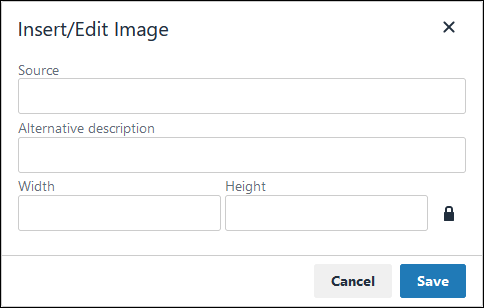
In the Source setting, enter a URL for the image.
In the Alternative Description setting, enter the text to display if the source URL of the image is not accessible.
In the Width setting, enter the maximum width for the image.
In the Height setting, enter the maximum height for the image.
Toggle the Constrain Proportions icon
 to maintain the width-height ratio of the image to its original proportion.
to maintain the width-height ratio of the image to its original proportion. Click Save.
Insert Page Break for PDF: Click on the Insert Page Break for PDF icon
 to insert a page break when a PDF document is created for this documentation if your browser supports this feature.
to insert a page break when a PDF document is created for this documentation if your browser supports this feature. Format text: Follow these guidelines to format text:
Headings: From the Paragraph/Formats menu, select Headings and then select a heading size.
Bold: Do one of the following:
From the editor toolbar, select the
 icon.
icon.From the Paragraph/Formats menu, select Inline and then Bold.
Italics: Do one of the following:
From the editor toolbar, select the
 icon.
icon.From the Paragraph/Formats menu, select Inline and then Italic.
Underline: From the Paragraph/Formats menu, select Inline and then Underline.
Strikethrough: From the Paragraph/Formats menu, select Inline and then Strikethrough.
Superscript: From the Paragraph/ Formats menu, select Inline and then Superscript.
Subscript: From the Paragraph/Formats menu, select Inline and then Subscript.
Code: From the Paragraph/Formats menu, select Inline and then Code.
Paragraph: From the Paragraph/Formats menu, select Blocks and then Paragraph.
Blockquote: From the Paragraph/Formats menu, select Blocks and then Blockquote.
Division: From the Paragraph/Formats menu, select Blocks and then Div.
Preformatted: From the Paragraph/Formats menu, select Blocks and then Pre.
Change text color: Use the Text Color drop-down to change text color. Click on the
 icon. The color palette displays. Do one of the following:
icon. The color palette displays. Do one of the following:Select one of the color swatches from the color palette. The selected text changes to that color.
Click the
 icon to select a custom color from the Color Picker.
icon to select a custom color from the Color Picker.Click the
 icon to reset the text to its default color.
icon to reset the text to its default color.
Align text: Follow these guidelines to align text:
Left align: Do one of the following:
From the editor toolbar, use the
 icon to left-align text.
icon to left-align text.From the Paragraph/Formats menu, select Align and then Left.
Center align: Do one of the following:
From the editor toolbar, use the
 icon to center-align text.
icon to center-align text.From the Paragraph/Formats menu, select Align and then Center.
Right align: Do one of the following:
From the editor toolbar, use the
 icon to right-align text.
icon to right-align text.From the Paragraph/Formats menu, select Align and then Right.
Justify: Do one of the following:
From the editor toolbar, use the
 icon to justify text.
icon to justify text. From the Paragraph/Formats menu, select Align and then Justify.
Insert a bullet list: Use the
 icon to format text as a bulleted list.
icon to format text as a bulleted list.Insert a numbered list: Use the
 icon to format text as a numbered list.
icon to format text as a numbered list.Indent text: Click on the
 icon to increase text indenting.
icon to increase text indenting.Outdent text: Click on the
 icon to decrease text indenting.
icon to decrease text indenting.
Assignment Rules Panel Settings
Select a task recipient and configure task re-assignment options.
Select to Whom to Assign the Manual Task
Instead of assign the Task's assignee using one or more rules, select to whom to assign a manual Task:
Users and/or groups: Assign that Task randomly to one user from a specified set of users and/or group members. ProcessMaker Platform assigns the Task to one user randomly. If that Task is not configured to allow that Task assignee to reassign that Task, then that person must complete that Task.
Previous Task assignee: Assign that Task to the previous Task assignee in that Request's workflow.
Request starter: Assign that Task to the user that started the Request.
Process Variable: Assign the Task to a user or group based on the value of a Request variable.
Process Manager: That Task assigns to the Process Manager when all other configured assignment conditions do not occur.
Optionally, affect how an assigned Task can route after the initial assignment:
Self service: Use the self-service Task option to allow self-service Task assignment. Doing so allows any member in a specified group assigned that Task to self-assign the Task from a queue. Note that the self-service Task option is not available unless assigning a Task to a user, group, via a Request variable, or rule expression.
Lock user assignment: Use the Lock User Assignment option to assign this Task to the same Task assignee if workflow in that Request returns to this Task. If the initial Task assignee was a member of a group, the Task is reassigned to the same group member. This option is useful if the initial Task assignee in the Request might need to provide clarification regarding information that Request participant initially submitted in that Task.
Allow reassignment: Enable the Allow Reassignment option to allow the Task assignee to reassign the Task if necessary. When using the Allow Reassignment option, the Reassign button displays in the Task summary to allow that Task assignee to reassign that Task. See View a Task Summary.
Allow manager escalation: Use the Allow Manager Escalation option to allow users to manually assign this Task to their manager. When this option is enabled, the Escalate to Manager button appears when viewing a Task's summary.
Assign to manager: Use the Assign to Manager option to assign that Task to the manager of that assignee's manager. As part of the Advanced User, an Administrator can configure the manager for each user. The user account for that Task assignee must be configured from each user's account to route that Task to the assignee's manager.
If this Manual Task object is configured to assign the Task to an anonymous person who started this Request via Web Entry, the settings described below are disabled because these Manual Task object settings only configure which authenticated user(s) may assigned this Task. Therefore, to configure these settings, either disable Web Entry or select that authenticated users may start Requests from this object via Web Entry. See Web Entry Panel Settings.
To allow the same anonymous person who started that Request or which authenticated users may be assigned the Manual Task object's Task via a published URL, do not configure those persons from the Assignment Rules panel. Configure those persons from the Web Entry panel.
Follow these steps to select to whom to assign the Task that is referenced in a Manual Task object:
Select the Manual Task object from the Process model in which to select the Task assignee.
Ensure that the Configuration panel displays. If not, show it. Panels to configure this object display.
Expand the Assignment Rules panel if it is not presently expanded. The Assignment Type setting displays. The Request Starter option is the default, thereby affecting options below it.
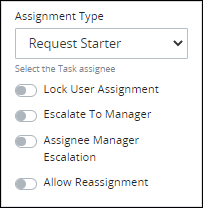
From the Assignment Type drop-down menu, select one of the following options:
Users / Groups: Select Users/Groups to assign the Task to a specified user or randomly to a group member. When this option is selected, the Assigned Users/Groups drop-down menu displays below the Assignment Type drop-down menu. Notice that the Self Service toggle key is available.
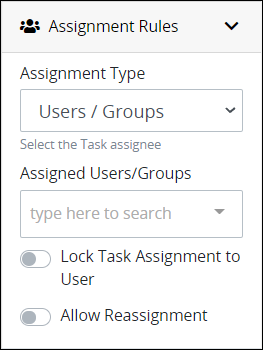
From the Assigned Users/Groups drop-down menu, select the person's full name or the name of a group as the Manual Task object's assignee. The Task is assigned following this protocol:
One user: The Task is assigned to the selected user.
One or more users and/or group(s): The Task is assigned randomly to one of those users or group members. The exception is if the Self Service toggle key is enabled, then the Task remains unassigned, in a queue, for one of those users to self-assign from the Self Service Task page.
Previous Task Assignee: Select Previous Task Assignee to assign the Task to who was assigned the previous Task in this Request. The Self Service toggle key is not available since the Task has a specific assignee.
Request Starter: Select Request Starter to assign the Task to the Request starter. This is the default option. The Self Service toggle key is not available since the Task has a specific assignee.
Process Variable: Select Process Variable to assign the Task determined by the value of a Request variable. The entered Request variable(s) may be one or both of the following:
Variable Name (Users): In the Variable Name (Users) setting, enter the Request variable that contains the user ID(s) for one or more users who might be assigned this Task. If more than one user ID is included the Request variable's value, then the Task is assigned randomly to one of those users. The exception is if the Self Service toggle key is enabled, then the Task remains unassigned, in a queue, for one of those users to self-assign from the Self Service Task page.
Variable Name (Groups): In the Variable Name (Groups) setting, enter the Request variable that contains the group ID(s) in which its members may be assigned this Task. The Task is assigned randomly to one of those users. The exception is if the Self Service toggle key is enabled, then the Task remains unassigned, in a queue, for one of those users to self-assign from the Self Service Task page.
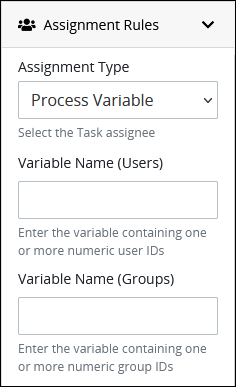
Rule Expression: Select Rule Expression to assign the Task's assignee using one or more rules. The rule expressions follow the Friendly Enough Expression Language (FEEL) syntax described in Expression Syntax Components. Notice that the Self Service toggle key is available.
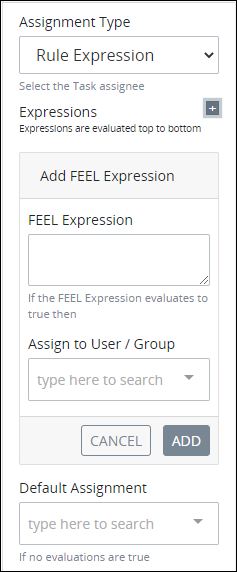
Each rule can only have one expression, but by using logical operators multiple conditions can be specified in that expression. You may use multiple rules to better confine the condition(s) to whom to assign the Task. You may use Magic Variables in your expression syntax. To add an expression, click the add
 button. The Add FEEL Expression settings display.
button. The Add FEEL Expression settings display. 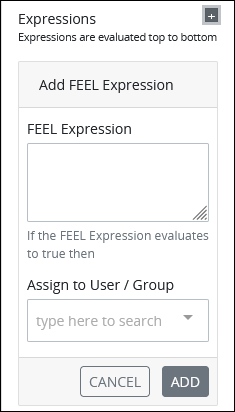
Follow these step to define an expression:
In the FEEL Expression setting, enter or edit the expression that determines that Manual Task object's Task assignee using the syntax components described in Expression Syntax Components, and then press Enter.
From the Assign to User/Group drop-down menu, select the user or group to whom to assign that Task if the expression in the FEEL Expression setting evaluates as True.
From the Default Assignment drop-down menu, select a user or group to assign that Task to if none of the expressions evaluate as True.
Process Manager: Select Process Manager to assign the Task to the Process Manager. Ensure to configure the Process Manager for this Process.
Enable the Self Service toggle key to allow self-service Task assignment. Doing so allows any member in a specified group assigned that Task to self-assign any Task from a queue. Note that the Self Service toggle key is not available unless the Users / Groups, Process Variable, or Rule Expression options are selected from the Assignment Type setting.
Enable the Assign to Manager toggle key to assign that Task to the manager of that assignee's manager. As part of the Advanced User, an Administrator can configure the manager for each user. The user account for that Task assignee must be configured from each user's account to route that Task to the assignee's manager.
Enable the Lock User Assignment toggle key to assign this Task to the same Task assignee if workflow in the Request returns to this Task. If the initial Task assignee was a member of a group, the Task is reassigned to the same group member. This option is useful if the initial Task assignee in the Request might need to provide clarification regarding information that Request participant initially submitted in that Task.
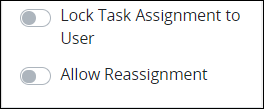
Enable the Allow Reassignment toggle key to allow the Task assignee to reassign the Task if necessary. If the Allow Reassignment option is enabled, the Reassign button displays in the Task summary to allow that Task assignee to reassign that Task. See View a Task Summary.
Enable the Escalate To Manager toggle key to automatically reassign this Task to the Task assignee's manager. As part of the Advanced User, an Administrator can configure the manager for each user.
Enable the Assignee Manager Escalation toggle key to automatically reassign this Task to the Task assignee's manager. As part of the Advanced User, an Administrator can configure the manager for each user.
If you enable the Allow Reassignment option, ensure that this Task is assigned to more than one user or to a group. Otherwise, despite the availability of the Reassign button in the Task summary, that Task assignee has no users to which to reassign this Task unless that user started that Request.
Notifications Panel Settings
Configure when to send task notifications. Task notifications are shown in ProcessMaker Platform and can be accessed using the Notifications .png) icon on the top right the screen. Task notifications can be sent to the following users:
icon on the top right the screen. Task notifications can be sent to the following users:
Requester: This is the user who started the process.
Task assignee: This is the user to whom the task is currently assigned.
Request participants: All users you have participated in the process.
Process Manager: The user set as the Process Manager in process configuration.
A copy of these notifications are also sent as automated emails to users. To disable these emails, see User Profile Setting.
To setup custom email notifications, see email notifications for Tasks.
Set Task Notifications
Task notifications can be sent to particpants when following events occur.
Task Notifications | |
|---|---|
Assigned | Send a notification when this task is assigned or reassigned. |
Completed | Send a notification when this task is completed |
Due | Send a notification when this task is due. |
Follow these steps to set Task notifications in a Form Task object:
Expand the Notifications panel.
.png)
From the Requester settings, set Task notifications for the Requester.
From the Assignee settings, set Task notifications for the assignee of the current task. The Assigned and Due notifications are enabled by default for task assignees.
From the Participant settings, set Task notifications for all process participants.
From the Process Manager settings, set Task notifications for the Process Manager.
Vocabularies Panel Settings
Vocabularies validate that Request data complies with a specific JSON schema. This is often mandatory for many types of business sectors including banking and healthcare ensuring the quality and compliance of Request data. For example, during a Loan Application process, ensure that all required personal information has been included in the Request.
Use a Vocabulary on a Form Task to validate that Request data complies with the Vocabulary's JSON schema after the Task assignee submits the Task. Multiple Vocabularies can be assigned to a Form Task object. During an in-progress Request, if the Request data no longer complies with all assigned Vocabularies, the Request status changes from In Progress to Error in the Request summary. Vocabularies are cumulative in an in-progress Request: as the Request progresses, if Request data does not conform with any Vocabulary's JSON schema, the request status displays an error. For more information What is a Vocabulary? and Create a New Vocabulary.
Assign Vocabularies That Validate Request Data
Follow these steps to assign Vocabularies that validate Request data from a Manual Task object:
Select the Manual Task object from the Process model in which to assign Vocabularies that validate Request data prior to when this object completes.
Ensure that the Configuration panel displays. If not, show it. Panels to configure this object display.Panels to configure this object display.
Expand the Vocabularies panel if it is not presently expanded. The Assigned setting displays.

Click the
 icon to add a Vocabulary. The Assign Vocabulary option displays.
icon to add a Vocabulary. The Assign Vocabulary option displays.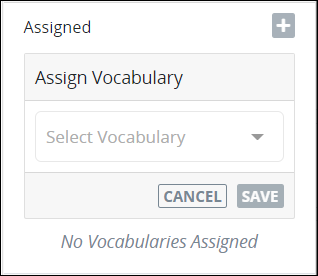
From the Select Vocabulary drop-down menu, select a Vocabulary from which to validate Request data complies with its JSON schema.
If no Vocabularies are configured, then the following message displays: List is empty. Create at least one Vocabulary. See Create a New Vocabulary.
Click Save.
Repeat Steps 3 through 6 as necessary for each Vocabulary required to validate Request data complies with its JSON schema.
Click the Remove icon
from the Vocabularies setting to remove a Vocabulary from assignment to this object.
After one or more Vocabularies are assigned to a Manual Task object, the Vocabulary icon displays in that object.
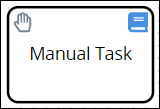
Advanced Panel Settings
Edit the Node's Identifier Value
Process Modeler automatically assigns a unique value to each Process node added to a Process model. However, a node's identifier value can be changed if it is unique to all other nodes in the Process model, including the Process model's identifier value.
All identifier values for all nodes in the Process model must be unique.
Follow these steps to edit the identifier value for a Manual Task object:
Select the Manual Task object from the Process model in which to edit its identifier value.
Ensure that the Configuration panel displays. If not, show it. Panels to configure this object display.
Expand the Advanced panel if it is not presently expanded. The Node Identifier setting displays. This is a required field.
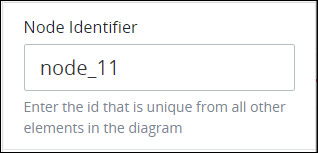
In the Node Identifier setting, edit the Manual Task object's identifier to a unique value from all nodes in the Process model and then press Enter.